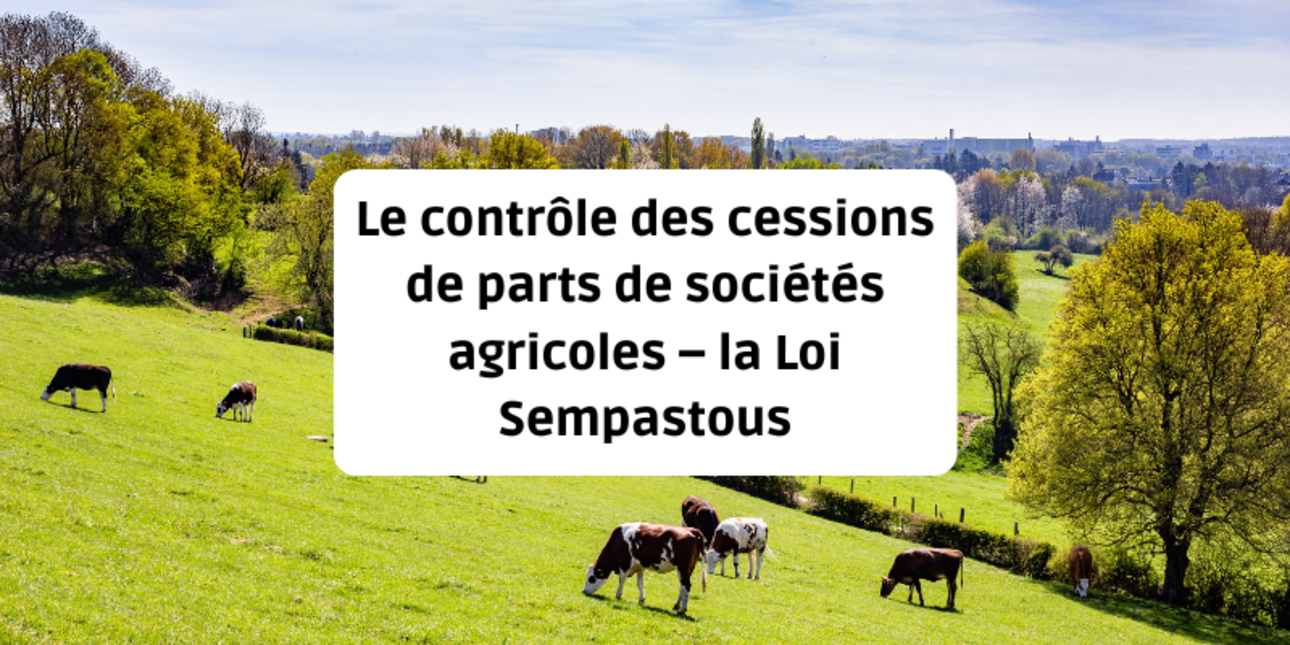
The Sempastous Law was introduced to control the transfer of farms through corporate structures. A few months after its implementation, we present the main features of this new regulation. From the origin of the law to its implementation at regional level, find out all about its specific features in this article.
Agricultural land has long been the subject of intense interest. In the 1960s, faced with the purchase of large tracts of farmland by non-farmers, the government introduced 2 land tools: cumulations (which have since become Contrôle des Structures) and the SAFER. The 1st tool controls who has the right to farm land and the 2nd tool controls who has the right to buy land.
Their objective was already to prevent the concentration of land in the hands of a few people and to support the installation of young farmers.
While these 2 regulations have not prevented a decline in the number of farmers, they have enabled us to maintain medium-sized farms (the family farming model) and to have the lowest farmland prices of all our European neighbours.

With the average size of farm holdings increasing, the agricultural landscape has changed dramatically over the last thirty years, with a huge increase in the number of agricultural companies.
Initially limited to GAECs (groupings of several farms) and GFAs (specific civil partnerships for holding land), agricultural partnerships have developed considerably in the form of EARLs (Exploitation Agricole à Responsabilité Limitée), SCEAs or SCEVs (Société Civile d'Exploitation Agricoles or Société Civile d'Exploitation Viticole) and commercial companies.
These new corporate forms meet farmers' expectations in terms of work organisation, social status, separation and protection of private, land and professional assets, tax and social optimisation, etc.
They have also had the effect (or main objective in some cases) of removing the application of the prerogatives of the Contrôle des Structures or the SAFER's right of pre-emption.
The acquisition by Chinese buyers of 2 farms totalling 2,600 hectares in the Indre and Allier regions through partial transfers of companies (sale of 99% of the shares in agricultural companies) made headlines in 2016 and 217. This legal path had enabled them to circumvent the application of the 2 regulations of the Contrôle des Structures and the SAFER.
The farming profession, with SAFER at the forefront, was outraged by these practices and campaigned for many years to be able to control the transfer of shares in these agricultural companies.
An initial law granting a right of first refusal on partial sales of shares in these companies was rejected by the Constitutional Council in 2017 (as a reminder, SAFER has a right of first refusal on total sales of shares in agricultural companies).
In 2018, a National Assembly mission on agricultural land chaired by MP Jean-Bernard Sempastous published an information report on these issues, recommending the introduction of a new control tool to prevent operations aimed at circumventing the Contrôle des Structures and SAFER's right of pre-emption.
The report will serve as the basis for a draft law to be presented by Mr Sempastous to the National Assembly on 9 February 2021. The "Sempastous Law" on "emergency measures to regulate access to agricultural land through corporate structures" was adopted and promulgated on 23 December 2021, and published in the Journal Officiel the following day.
SAFER and the farming profession lobbied for over 10 years before succeeding in introducing this new control system.
But the practical application of the law was itself laborious.
Adopted on 23 December 2021, the law was published in the Journal Officiel on 24 December 2021 and was due to come into force on 1 July 2022 at the latest.
As with any law, its entry into force requires the publication of decrees, prefectoral orders, etc.
This was to be a complex task, as the implementing decree, which was a prerequisite for the other texts, was not published until 4 December 2022, a year after the law was passed, despite the urgency initially envisaged.
As a result, the law was not fully implemented until 1 April 2023, 9 months late.
There are 2 distinct regimes (declaration and authorisation) as well as operations that are exempt from c ontrol.
ontrol.
From 1 January 2023, all sales of shares in companies that own or use (lease or make available) agricultural land must be declared online for information purposes.
And since 1 March, applications for authorisation have been required for operations leading to a takeover and exceeding a surface area threshold defined by prefectoral decree.
Once the application has been examined, the prefectoral decision may result in a refusal, even in the absence of a competing application (unlike the Contrôle des Structures or the SAFER's right of pre-emption), or authorise the transfer subject to compensatory measures. The applicant will then have to make the land available for sale or rent.
To determine whether control has been acquired ("an interest in the capital which confers, de jure or de facto, the majority of voting rights; generally, voting rights are proportional to the number of shares held by each shareholder", according to the French Commercial Code), the authorities look to see who actually has the power to manage and administer the company, without limiting themselves to a single criterion of the percentage of share capital held.
Thus, there is a presumption of control if one person holds more than 40% of the voting rights and no other shareholder holds the same or more rights.
Similarly, "Two or more persons acting in concert shall be deemed to jointly control another where they determine the decisions taken at a general meeting". This suggests that family ties are likely to constitute concerted action.
Transactions carried out out of court by SAFERs are exempt.
So are transfers of shares between spouses (or civil partners) and between relatives up to the 4th degree. However, on condition that the beneficiary of the transfer undertakes to participate in the operation of the property and to hold the shares for at least 9 years.
Lastly, free transfers (gifts, inheritances, etc.) are also exempt.
The thresholds defined for each region can be consulted in the regulations section of the SAFER website.
The application thresholds vary widely from region to region:
Some very large regions use a single threshold, while other regions use different thresholds for different departments.
There are, of course, coefficients of equivalence determined according to production. This is why it is necessary to refer to the Schéma Directeur Régional des Exploitations Agricoles (Regional Farm Master Plan) defined for each region.
|
Région |
Seuil |
|
Auvergne-Rhône-Alpes : SDREA, arrêté de seuil |
Région naturelle 1 : 177 hectares Région naturelle 2 : 94 hectares Région naturelle 3 : 108 hectares |
|
Bourgogne-Franche-Comté : SDREA, arrêté de seuil |
Zone 1 : 185 hectares Zone 2 : 227 hectares Zone 3 : 282 hectares |
|
Bretagne : SDREA, arrêté de seuil |
93 hectares |
|
Centre-Val de Loire : SDREA, arrêté de seuil |
275 hectares |
|
Corse : SDREA, arrêté de seuil |
86 hectares |
|
Grand Est : SDREA, arrêté de seuil |
Régions agricoles « Montage Vosgienne » : 129 hectares Reste de la région : 222 hectares |
|
Hauts-de-France : SDREA, arrêté de seuil |
Nord, Pas-de-Calais : 140 hectares Aisne, Oise, Somme : 200 hectares |
|
Ile-de-France : SDREA, arrêté de seuil |
342,50 hectares |
|
Nouvelle-Aquitaine : SDREA, arrêté de seuil |
120 hectares |
|
Normandie : SDREA, arrêté de seuil |
148 hectares |
|
Occitanie : SDREA, arrêté de seuil |
Zones 3 et 5 : 115 hectares Zones 1,2,4 et 6 : 150 hectares |
|
Pays de la Loire : SDREA, arrêté de seuil |
150 hectares |
|
Provence-Alpes-Côte d'Azur : SDREA, arrêté de seuil |
127,50 hectares |
|
Guadeloupe : SDREA, arrêté de seuil |
13,20 hectares |
|
Martinique : SDREA, arrêté de seuil |
25 hectares |
|
Réunion : SDREA, arrêté de seuil |
9 hectares |
This formality must be carried out at least 2 months before the planned date of transfer, whether the transaction is for valuable consideration (sale) or free of charge (donation, inheritance).
This control has been entrusted to SAFER, which has set up a specific internet portal: the "Portal for remote declaration of corporate transactions".
The formality must therefore be completed online. There are 4 forms to complete:
A great deal of information needs to be filled in and a large number of documents need to be attached.

The deadlines for this new procedure are particularly long from the time the form is submitted online:
In other words, 4 months and 10 days for a standard application.
When examining the application, SAFER may ask the applicant to implement compensatory measures. If this proposal is approved by the Prefect and then accepted by the applicant, the latter has 6 months to implement the measures.
If the Prefect refuses, the applicant may propose compensatory measures (freeing up land), which opens up new deadlines:
These new regulations are particularly burdensome and generate additional delays for operations leading to "excessive enlargement", as well as for all corporate operations subject to declaration, given the 2-month prior period.
The fact that SAFERs carry out these checks is also a source of criticism, as SAFERs are regional companies governed by private law. Although they have a public service remit, they are themselves transfer operators (for a fee) on this same market.
Finally, it is also a pity that the procedure has not been unified with the Contrôle des Structures and the SAFER's right of pre-emption in order to simplify the administrative procedures, even though it is now just another layer.